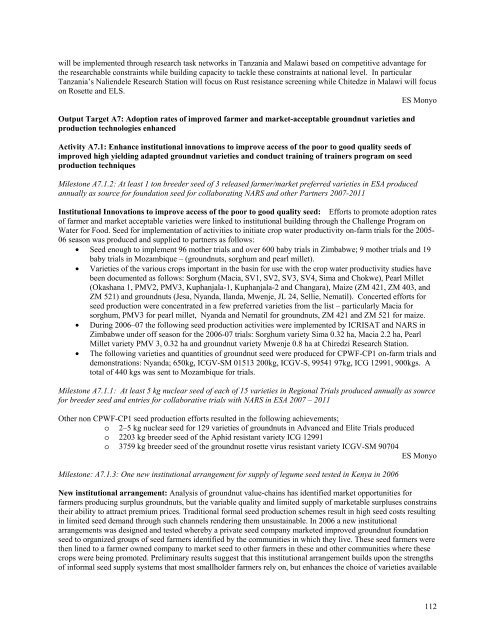ICRISAT Archival Report 2006 - The seedlings of success in the ...
ICRISAT Archival Report 2006 - The seedlings of success in the ...
ICRISAT Archival Report 2006 - The seedlings of success in the ...
Create successful ePaper yourself
Turn your PDF publications into a flip-book with our unique Google optimized e-Paper software.
will be implemented through research task networks <strong>in</strong> Tanzania and Malawi based on competitive advantage for<br />
<strong>the</strong> researchable constra<strong>in</strong>ts while build<strong>in</strong>g capacity to tackle <strong>the</strong>se constra<strong>in</strong>ts at national level. In particular<br />
Tanzania’s Naliendele Research Station will focus on Rust resistance screen<strong>in</strong>g while Chitedze <strong>in</strong> Malawi will focus<br />
on Rosette and ELS.<br />
ES Monyo<br />
Output Target A7: Adoption rates <strong>of</strong> improved farmer and market-acceptable groundnut varieties and<br />
production technologies enhanced<br />
Activity A7.1: Enhance <strong>in</strong>stitutional <strong>in</strong>novations to improve access <strong>of</strong> <strong>the</strong> poor to good quality seeds <strong>of</strong><br />
improved high yield<strong>in</strong>g adapted groundnut varieties and conduct tra<strong>in</strong><strong>in</strong>g <strong>of</strong> tra<strong>in</strong>ers program on seed<br />
production techniques<br />
Milestone A7.1.2: At least 1 ton breeder seed <strong>of</strong> 3 released farmer/market preferred varieties <strong>in</strong> ESA produced<br />
annually as source for foundation seed for collaborat<strong>in</strong>g NARS and o<strong>the</strong>r Partners 2007-2011<br />
Institutional Innovations to improve access <strong>of</strong> <strong>the</strong> poor to good quality seed: Efforts to promote adoption rates<br />
<strong>of</strong> farmer and market acceptable varieties were l<strong>in</strong>ked to <strong>in</strong>stitutional build<strong>in</strong>g through <strong>the</strong> Challenge Program on<br />
Water for Food. Seed for implementation <strong>of</strong> activities to <strong>in</strong>itiate crop water productivity on-farm trials for <strong>the</strong> 2005-<br />
06 season was produced and supplied to partners as follows:<br />
• Seed enough to implement 96 mo<strong>the</strong>r trials and over 600 baby trials <strong>in</strong> Zimbabwe; 9 mo<strong>the</strong>r trials and 19<br />
baby trials <strong>in</strong> Mozambique – (groundnuts, sorghum and pearl millet).<br />
• Varieties <strong>of</strong> <strong>the</strong> various crops important <strong>in</strong> <strong>the</strong> bas<strong>in</strong> for use with <strong>the</strong> crop water productivity studies have<br />
been documented as follows: Sorghum (Macia, SV1, SV2, SV3, SV4, Sima and Chokwe), Pearl Millet<br />
(Okashana 1, PMV2, PMV3, Kuphanjala-1, Kuphanjala-2 and Changara), Maize (ZM 421, ZM 403, and<br />
ZM 521) and groundnuts (Jesa, Nyanda, Ilanda, Mwenje, JL 24, Sellie, Nematil). Concerted efforts for<br />
seed production were concentrated <strong>in</strong> a few preferred varieties from <strong>the</strong> list – particularly Macia for<br />
sorghum, PMV3 for pearl millet, Nyanda and Nematil for groundnuts, ZM 421 and ZM 521 for maize.<br />
• Dur<strong>in</strong>g <strong>2006</strong>–07 <strong>the</strong> follow<strong>in</strong>g seed production activities were implemented by <strong>ICRISAT</strong> and NARS <strong>in</strong><br />
Zimbabwe under <strong>of</strong>f season for <strong>the</strong> <strong>2006</strong>-07 trials: Sorghum variety Sima 0.32 ha, Macia 2.2 ha, Pearl<br />
Millet variety PMV 3, 0.32 ha and groundnut variety Mwenje 0.8 ha at Chiredzi Research Station.<br />
• <strong>The</strong> follow<strong>in</strong>g varieties and quantities <strong>of</strong> groundnut seed were produced for CPWF-CP1 on-farm trials and<br />
demonstrations: Nyanda; 650kg, ICGV-SM 01513 200kg, ICGV-S, 99541 97kg, ICG 12991, 900kgs. A<br />
total <strong>of</strong> 440 kgs was sent to Mozambique for trials.<br />
Milestone A7.1.1: At least 5 kg nuclear seed <strong>of</strong> each <strong>of</strong> 15 varieties <strong>in</strong> Regional Trials produced annually as source<br />
for breeder seed and entries for collaborative trials with NARS <strong>in</strong> ESA 2007 – 2011<br />
O<strong>the</strong>r non CPWF-CP1 seed production efforts resulted <strong>in</strong> <strong>the</strong> follow<strong>in</strong>g achievements;<br />
o 2–5 kg nuclear seed for 129 varieties <strong>of</strong> groundnuts <strong>in</strong> Advanced and Elite Trials produced<br />
o 2203 kg breeder seed <strong>of</strong> <strong>the</strong> Aphid resistant variety ICG 12991<br />
o 3759 kg breeder seed <strong>of</strong> <strong>the</strong> groundnut rosette virus resistant variety ICGV-SM 90704<br />
ES Monyo<br />
Milestone: A7.1.3: One new <strong>in</strong>stitutional arrangement for supply <strong>of</strong> legume seed tested <strong>in</strong> Kenya <strong>in</strong> <strong>2006</strong><br />
New <strong>in</strong>stitutional arrangement: Analysis <strong>of</strong> groundnut value-cha<strong>in</strong>s has identified market opportunities for<br />
farmers produc<strong>in</strong>g surplus groundnuts, but <strong>the</strong> variable quality and limited supply <strong>of</strong> marketable surpluses constra<strong>in</strong>s<br />
<strong>the</strong>ir ability to attract premium prices. Traditional formal seed production schemes result <strong>in</strong> high seed costs result<strong>in</strong>g<br />
<strong>in</strong> limited seed demand through such channels render<strong>in</strong>g <strong>the</strong>m unsusta<strong>in</strong>able. In <strong>2006</strong> a new <strong>in</strong>stitutional<br />
arrangements was designed and tested whereby a private seed company marketed improved groundnut foundation<br />
seed to organized groups <strong>of</strong> seed farmers identified by <strong>the</strong> communities <strong>in</strong> which <strong>the</strong>y live. <strong>The</strong>se seed farmers were<br />
<strong>the</strong>n l<strong>in</strong>ed to a farmer owned company to market seed to o<strong>the</strong>r farmers <strong>in</strong> <strong>the</strong>se and o<strong>the</strong>r communities where <strong>the</strong>se<br />
crops were be<strong>in</strong>g promoted. Prelim<strong>in</strong>ary results suggest that this <strong>in</strong>stitutional arrangement builds upon <strong>the</strong> strengths<br />
<strong>of</strong> <strong>in</strong>formal seed supply systems that most smallholder farmers rely on, but enhances <strong>the</strong> choice <strong>of</strong> varieties available<br />
112

















